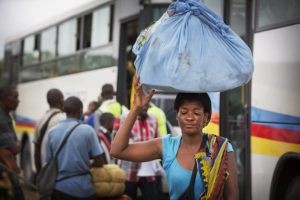The NDP and Poverty Reduction in the Congo
 The Republic of the Congo (ROC) begins to see light at the end of a dark tunnel filled with poverty and famine. Situated in the central-western portion of sub-Saharan Africa alongside the neighboring Democratic Republic of the Congo (DRC), ROC heavily relies on its exports of petroleum, timber and raw materials to sustain its economy.
The Republic of the Congo (ROC) begins to see light at the end of a dark tunnel filled with poverty and famine. Situated in the central-western portion of sub-Saharan Africa alongside the neighboring Democratic Republic of the Congo (DRC), ROC heavily relies on its exports of petroleum, timber and raw materials to sustain its economy.
Although it remains under tight strain due to ongoing riots and armed conflict in the DRC, the ROC is determined to continue its “march toward development” and enable the country to “join the circle of emerging developed countries,” according to the International Monetary Fund (IMF). Hence, shortly after the 2021 elections in the Congo, President Denis Sassou Nguesso introduced the National Development Plan (NDP) for 2022-2026.
The NDP in the Congo: An Overview
The NDP aims to alleviate poverty alongside other necessary economic measures to reduce the effects of the COVID-19 Pandemic. It is dedicated to improving the standard quality of life in the Congo. According to official records by the ROC in its NDP, economic activity contracted to a gross domestic product (GDP) growth rate of around -6.2% due to the impacts of the pandemic and the later collapse of world oil prices, from which the country heavily depends economically. The poverty rate has also been estimated to have increased dramatically to 52.5% as of 2020.
The plan, developed by Nguesso and approved by the Congolese government, prioritizes diversifying exports and income sources. This focus aims to mitigate the impact of global economic shocks that have slowed the Congo’s GDP growth in recent years. However, with the NDP and its funding of around $14.7 billion, the plan aims to develop agriculture broadly to fight against the growing issue of poverty in the nation.
Through legislation such as the National Social Action Policy (NSAP) and the NDP, the Congolese government aims to create many decent jobs and provide a “noncontributory social protection base” for those in need. This approach is intended to enhance the economic prospects of impoverished rural and urban populations, reduce poverty and improve the overall quality of life in the Congo.
The ROC Today
Due to these initiatives being undertaken by the Congo Government, the World Bank notes that the GDP of the Republic is expected to grow at a rate of 3.5% in 2024 and hover at a consistent 3.4% on average in 2025-2026, signaling that the plan is having its intended effect on the Congo’s economy. The World Bank also notes that “although debt vulnerabilities remain elevated to this day, the debt-to-GDP ratio (a measurement of how much total federal debt is there as a percentage of the current GDP of the nation) is projected to decline slowly to 81% by 2026”, a massive step from the previous 96% in 2023.
The United States currently has a debt-to-GDP ratio of around 122%, highlighting how much progress has been made to improve the general quality of life in the Congo and calling for good times ahead for the Congolese and the Republic of the Congo.
– Aarush Kanduri
Aarush Kanduri is based in Iselin, NJ and focuses on Good News for The Borgen Project.
Photo: Flickr
